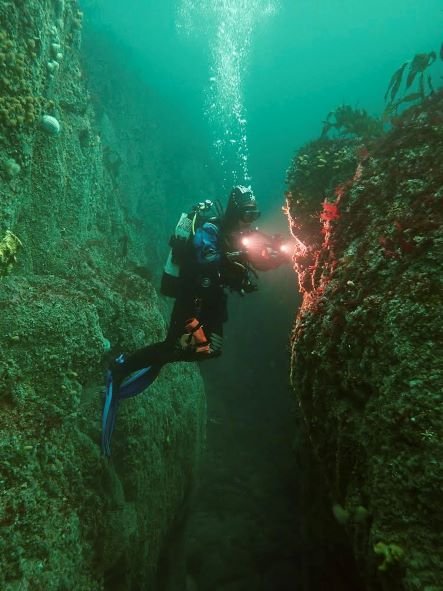
Dive into the fascinating world of Seasearch
4 minute read
This year, we’re celebrating 35 years of our Seasearch project. We chatted with diving enthusiast and Seasearch co-ordinator for Northern Ireland, Libby Keatley, to find out about the project and her experience in our wonderful seas.
What first got you interested in diving?
How did you get involved with Seasearch?
As soon as I saw the marine life we have here, I had to learn more about it. I started out leafing through the ‘Seasearch Diver’s Guide to Marine Life’ after my dives and trying to learn how to identify as many species as I could.
When I came across a spiny lobster (Palinurus elephas) at a local dive site where they’d never been recorded before, I got in touch with the then Seasearch coordinator, Sally, who was really encouraging and invited me to come along on the last Seasearch dive of that year.
I quickly realised this was where I belonged, and I haven’t looked back since. I’m an active volunteer with Seasearch and absolutely love to get out for a dive with the team. Last year, I started helping with some of the co-ordinating duties as well, and I’m really excited to take on the role of co-ordinator for Northern Ireland this coming year.

Some of the Seasearch team heading out for a dive
Credit: Phil Wilkinson
What do you do as part of Seasearch?
Seasearch divers are all volunteers, which I think is fantastic. It’s really encouraging to see so many people who care about the marine environment and help gather data to help protect it.
On our dives, we carry out an underwater survey of a particular site - recording habitat details, species found there and the conditions at the time of surveying. The sites we dive in are chosen because they’re identified as important for a particular reason (like being a ‘priority habitat’ or containing ‘priority species’) or if there’s a lack of data, so the specific focus each dive varies.
Generally anything and everything gets recorded, but there’s a particular focus on species and habitats that have been identified as ‘priority’ due to their scarcity, being in decline, or under threat. We’re also interested in recording and monitoring invasive species.
As well as taking parts in dives, from this year I’ll also be helping to direct Seasearch surveys and collate the data, which I’m really looking forward to.
What do the findings from Seasearch dives tell us?
It depends on the dive, but the data we gather can be used to make a real difference.
What’s the most interesting thing you’ve ever found on a dive?
I think my most interesting finds so far have been two rare nudibranchs.
When diving the Skerries in Portstewart, I came across one that turned out to be a species that isn’t yet described! I was lucky to be with a nudibranch expert at the time who collected a sample and brought it to the QUB marine laboratory as part of a DNA barcoding project. This is one of the wonderful things about Seasearch - working with knowledgeable people who can make use of the finds and data!
The other is one I came across whilst diving off the coast of Donegal. Up until then, the Diaphorodoris alba had only been recorded as far north as Pembrokeshire, Wales, so this is the only record of this species for the island of Ireland so far! It’ll be interesting to see if more records start to show up now that this one has been found, though.
What’s your favourite thing about being part of Seasearch?
I love being part of Seasearch for a lot of reasons. I really enjoy learning about our marine life and Seasearch provides a fantastic opportunity to do this. It’s even better doing this alongside a team of like-minded people - you don’t get blank stares when you get really excited about seeing a rarely recorded nudibranch, you come back to a boat-full of people who are excited to hear about your finds and share their own with you!
With Seasearch, there’s always something new to see. The more you look and more you learn, the more you tend to find. It’s one of the reasons I’d strongly recommend joining Seasearch to any qualified diver interested in marine life or conservation – it adds so much to your diving and gives you a purpose and focus.
Personally, I’ve gained so much out of my volunteering with Seasearch, so I want to be able to give a lot back in my new role. As co-ordinator, I’m hoping to help protect the marine life we have here by gathering lots of records and running training events, organising some great diving, having fun with my fellow Seasearchers, and spreading the word about Seasearch so other marine life enthusiasts can find their home too!






